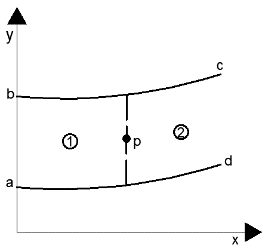This set of Computational Fluid Dynamics Multiple Choice Questions & Answers (MCQs) focuses on “Mathematical Behaviour of PDE – Parabolic Equations”.
1. Which of these are associated with a parabolic equation?
a) Initial and boundary conditions
b) Initial conditions only
c) Boundary conditions only
d) Neither initial conditions nor boundary conditions
View Answer
Explanation: Initial conditions come into the picture as parabolic equations are marching. This marching is done along the boundary conditions. Thus, both the initial conditions and boundary conditions are necessary for parabolic equations.
2. Consider the flowing diagram.

Which of these flows can be represented by this diagram?
a) Steady viscous flow
b) Transient viscous flow
c) Transient inviscid flow
d) Steady inviscid flow
View Answer
Explanation: The diagram represents parabolic equations. Transient viscous flows such as boundary layer flows are parabolic. So, the diagram can represent transient viscous flows and not the others.
3. Which among these problems is parabolic?
a) Steady inviscid flow
b) Steady state heat conduction
c) Unsteady heat conduction
d) Unsteady inviscid flow
View Answer
Explanation: Unsteady heat conduction is a parabolic equation which marches through the time axis. When the problem reaches equilibrium, the rod gets a uniform distribution of temperature.
4. Imagine the point ‘p’ in the diagram is disturbed by some external conditions.

Which of these regions will be affected by this disturbance?
a) Neither 1 nor 2
b) Both 1 and 2
c) 1 only
d) 2 only
View Answer
Explanation: Parabolic equations have marching solution. So, any disturbance at any point in the flow will affect only the flow behind it and not the flow ahead of it. So, region 2 will only be influenced by the disturbance.
5. Imagine a parabolic flow represented by this diagram.

Which of these lines represent initial conditions?
a) ab
b) p
c) ab
d) ad
View Answer
Explanation: Parabolic equations in this diagram march from line ‘ab’ and move along the positive x-direction. So, the initial conditions are given by line ‘ab’.
6. Supersonic viscous problems _________
a) are always circular
b) cannot be parabolic
c) are parabolic
d) can be parabolized
View Answer
Explanation: Supersonic viscous problems are governed by Navier-Stokes equations. Some assumptions made in this Navier-Stokes equations will give parabolic equations called Parabolized Navier Stokes equations.
7. Which of these equations is not parabolic?
a) \(\rho\dot{q}\frac{\partial}{\partial x}(k\frac{\partial T}{\partial x})+\frac{\partial}{\partial y}(k\frac{\partial T}{\partial y})+\frac{\partial}{\partial z}(k\frac{\partial T}{\partial z})=\rho\frac{\partial e}{\partial t}\)
b) \(\rho\dot{q}+\frac{\partial}{\partial x}(k\frac{\partial T}{\partial x})=\rho\frac{\partial e}{\partial t}\)
c) \(\frac{1}{\rho C_v}[\frac{\partial}{\partial x}(k\frac{\partial T}{\partial x})+\frac{\partial}{\partial y}(k \frac{\partial T}{\partial y})+\frac{\partial}{\partial z}(k\frac{\partial T}{\partial z})]=\frac{\partial T}{\partial t} \)
d) \(\frac{\partial}{\partial x}(k\frac{\partial T}{\partial x})+\frac{\partial}{\partial y}(k \frac{\partial T}{\partial y})+\frac{\partial}{\partial z}(k\frac{\partial T}{\partial z})=0\)
View Answer
Explanation: \(\frac{\partial}{\partial x}(k\frac{\partial T}{\partial x})+\frac{\partial}{\partial y}(k \frac{\partial T}{\partial y})+\frac{\partial}{\partial z}(k\frac{\partial T}{\partial z})=0\) represents steady heat conduction and it is elliptic. The other three equations represent unsteady heat conduction and they are parabolic.
8. Imagine a parabolic flow represented by this diagram.

What does the line ‘ad’ represent?
a) Right characteristic line
b) Left characteristic line
c) Boundary condition
d) Initial condition
View Answer
Explanation: Lines ‘bc’ and ‘ad’ form the boundary of the flow. They represent the boundary conditions of the parabolic problem. The solutions march along these boundary lines.
9. Which of these assumptions are made for parabolizing Navier-Stokes equations?
a) Viscous terms are neglected
b) Viscous terms with derivatives in the stream-wise direction are neglected
c) Derivatives in the stream-wise direction are neglected
d) Viscous terms in the stream-wise direction are neglected
View Answer
Explanation: Parabolized Navier-Stokes equations can be used for supersonic flows over sharp-nosed cones. In this case, the flow field does not involve any reversed or separated flows. So, the derivatives of the viscous terms in the stream-wise direction are neglected and the equations are parabolized.
10. Which of these apply to parabolic equations?
a) They have one real characteristic line
b) They have two real characteristic lines
c) They have two imaginary characteristic lines
d) They do not have characteristic lines
View Answer
Explanation: Parabolic equations have their determinant equal to zero. So, they get only one real characteristic line through the point considered.
Sanfoundry Global Education & Learning Series – Computational Fluid Dynamics.
To practice all areas of Computational Fluid Dynamics, here is complete set of 1000+ Multiple Choice Questions and Answers.
If you find a mistake in question / option / answer, kindly take a screenshot and email to [email protected]
- Check Computational Fluid Dynamics Books
- Check Mechanical Engineering Books
- Practice Mechanical Engineering MCQs
- Practice Chemical Engineering MCQs
- Check Chemical Engineering Books
